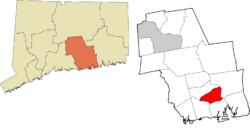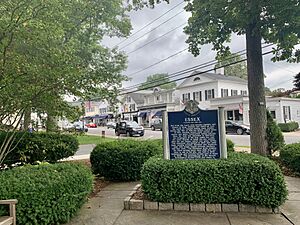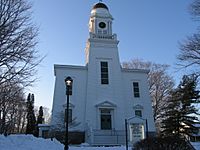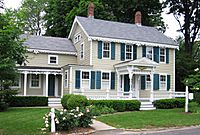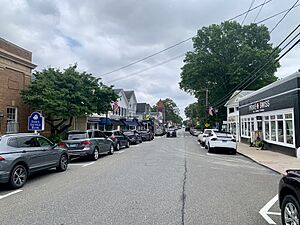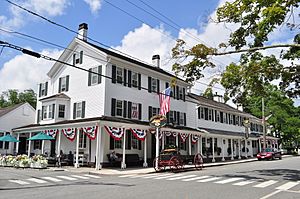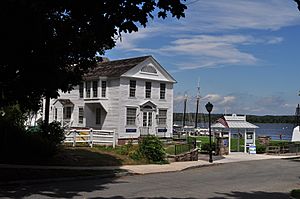Essex, Connecticut facts for kids
Quick facts for kids
Essex, Connecticut
|
||
|---|---|---|
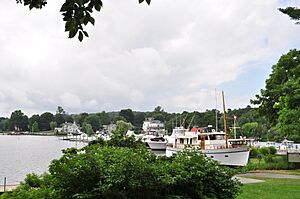
View from Essex Park
|
||
|
||
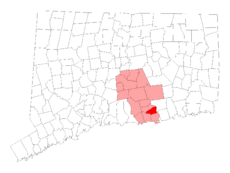 Middlesex County and Connecticut Middlesex County and Connecticut |
||
| Country | ||
| U.S. state | ||
| County | Middlesex | |
| Region | Lower CT River Valley | |
| Incorporated | 1852 | |
| Name changed | 1854 | |
| Government | ||
| • Type | Selectman-town meeting | |
| Area | ||
| • Total | 11.8 sq mi (30.6 km2) | |
| • Land | 10.4 sq mi (26.8 km2) | |
| • Water | 1.5 sq mi (3.8 km2) | |
| Elevation | 39 ft (12 m) | |
| Population
(2020)
|
||
| • Total | 6,733 | |
| • Density | 651/sq mi (251.2/km2) | |
| Time zone | UTC−5 (Eastern) | |
| • Summer (DST) | UTC−4 (Eastern) | |
| ZIP code |
06409, 06426, 06442
|
|
| Area code(s) | 860/959 | |
| FIPS code | 09-26270 | |
| GNIS feature ID | 0213428 | |
Essex is a town in Middlesex County, Connecticut, United States. It's part of the Lower Connecticut River Valley Planning Region. In 2020, about 6,733 people lived there.
Essex is made up of three smaller areas called villages: Essex Village, Centerbrook, and Ivoryton.
Contents
History
The Great Attack of 1814
Essex is one of the few American towns ever attacked by a foreign country. This happened on April 8, 1814, during the War of 1812. The attack caused a lot of damage, making it one of the biggest losses for the United States in that war.
British soldiers destroyed 28 ships in Essex. These ships were worth about $200,000 at the time. This was a huge amount of money back then! Some historians have even called it the "Pearl Harbor" of the War of 1812.
On that day, about 136 British marines and sailors came from four warships. They rowed six boats up the Connecticut River in the early morning. They passed an empty fort in Old Saybrook and arrived in Essex around 4 A.M.
The British soldiers had swivel guns, swords, pistols, and muskets. They quickly took over the town. They promised not to harm the people or burn their homes if the local militia didn't fight back.
The British took rope and a lot of rum from the town's stores. But their main goal was to burn the new privateer ships in the harbor. These ships were almost ready to sail.
Within six hours, their mission was done. The British left with two captured ships. However, they got stuck in the river because of low tide. Volunteers from Killingworth, Connecticut shot at them from the riverbanks. Two marines were killed, and the captured ships had to be destroyed. The rest of the British soldiers escaped when the tide came back in.
Before the raid, Essex (then called Potopaug) was a big center for shipping and shipbuilding. The town was suffering because the British were blocking trade. This is why privateer ships were being built. One ship, the Black Prince, was advertised as a great privateer. This might have made the British decide to attack Essex. After the raid, the town's name was changed to Essex.
Every second Saturday in May, people in Essex remember the "Burning of the Ships." A group called the "Sailing Masters of 1812" has a parade. They wear old United States naval uniforms and play fife and drum music.
The Connecticut River Museum is located where the British landed. It has an exhibit about the raid. You can see a large diorama (a 3D model scene) and even a piece of a ship burned by the British.
Old Buildings and Architecture
Centerbrook was the main part of Essex until the Revolutionary War. Many old farmhouses from that time are still there. These include large two-story homes with central chimneys and smaller Cape Cod-style homes. The oldest church building in Middlesex County is the Congregational Church in Centerbrook.
Essex Village (once called Potapoug Point) grew a lot between the American Revolution and the Civil War. This was because of shipbuilding. Many homes were built between 1790 and 1820. Main Street looked much like it does today. Many homes were in the Federal style. The Hayden family, who owned a shipyard, built many of these homes near the waterfront.
The First Baptist Church of Essex, Connecticut on Prospect Street was built in 1846. It's special because it's one of only three churches in the United States built in the Egyptian Revival style.
After wooden sailing ships became less common, the ivory and piano parts industry grew in Ivoryton. This made Ivoryton a very important part of Essex. Many houses built after the Civil War in Ivoryton show how rich and important the village became. East Main Street, entering Ivoryton, has many Victorian-style houses. These were owned by people who worked for Comstock, Cheney & Co., a big ivory company.
From 1890 to 1920, many immigrants came to Ivoryton to work in the factory. The company built many homes for these workers. Most of these "factory homesteads" are still standing today. You can see them on streets like Blake, Oak, Walnut, and Chestnut. They offer a look into the past.
Geography and Climate
Essex covers about 11.8 square miles (30.6 square kilometers). About 10.4 square miles (26.8 square kilometers) is land, and 1.5 square miles (3.8 square kilometers) is water.
The town has three main villages: Essex (ZIP code 06426), Centerbrook (06409), and Ivoryton (06442). The local public school, Essex Elementary School, teaches students from kindergarten to 6th grade.
Climate Essex has four clear seasons.
- In Autumn, leaves change colors, and temperatures get cooler.
- Winter usually brings snow from December to March. January is the coldest month.
- Spring is pleasant, with temperatures often in the 60s Fahrenheit.
- Summertime is warm and humid. July temperatures often reach the 80s Fahrenheit.
People of Essex
| Historical population | |||
|---|---|---|---|
| Census | Pop. | %± | |
| 1850 | 950 | — | |
| 1860 | 1,764 | 85.7% | |
| 1870 | 1,669 | −5.4% | |
| 1880 | 1,855 | 11.1% | |
| 1890 | 2,035 | 9.7% | |
| 1900 | 2,530 | 24.3% | |
| 1910 | 2,745 | 8.5% | |
| 1920 | 2,815 | 2.6% | |
| 1930 | 2,777 | −1.3% | |
| 1940 | 2,859 | 3.0% | |
| 1950 | 3,491 | 22.1% | |
| 1960 | 4,057 | 16.2% | |
| 1970 | 4,911 | 21.1% | |
| 1980 | 5,078 | 3.4% | |
| 1990 | 5,904 | 16.3% | |
| 2000 | 6,505 | 10.2% | |
| 2010 | 6,683 | 2.7% | |
| 2020 | 6,733 | 0.7% | |
| U.S. Decennial Census | |||
In 2000, there were about 6,505 people living in Essex. The population was spread out by age:
- 21.9% were under 18 years old.
- 27.4% were between 25 and 44 years old.
- 19.5% were 65 years or older.
The average age was 43 years.
Most households were married couples living together. About 31.8% of households had people living alone.
Religion
Essex has a Lutheran Church on Main Street in Centerbrook. There is also a building that used to be a Methodist church, but it's not used anymore.
The First Baptist Church of Essex, Connecticut, built in 1846, is famous. It's one of only three churches in the United States built in the Egyptian revival style.
There is also a Catholic Church, Our Lady of Sorrows, in Essex Village. It was rebuilt in 1925 after a fire.
Education
Essex is part of Regional School District #4, along with Deep River and Chester.
- Essex Elementary School is in Centerbrook. It serves students from Pre-K to 6th grade.
- John Winthrop Junior High School in Deep River is for grades 7 and 8.
- Valley Regional High School in Deep River is for grades 9–12.
Fun Things to Do
Essex has some unique traditions and attractions:
- Groundhog Day Parade: Every year, the town has a parade for Groundhog Day. A big papier-mâché groundhog named "Essex Ed" is carried through town. People make noise to wake him up and hope winter ends soon!
- Loser's Day Parade: This parade celebrates the 1814 attack when British marines burned ships in the harbor. It's a way to remember that historical event.
- Shad Bake: The Rotary Club of Essex holds a Shad Bake on the first Saturday in June.
The Essex Savings Bank was founded in 1851. It's one of the oldest banks still working in Connecticut.
The Essex Art Association Gallery was started in 1946 by artists. It's in an old schoolhouse and shows art during the summer.
The Essex Steam Train is a very popular attraction.
- You can take a train ride from Essex to Deep River.
- Then, the Becky Thatcher Riverboat takes passengers up the Connecticut River.
- The Essex Clipper Dinner Train offers a special dinner ride.
- Sometimes, Thomas the Tank Engine visits, which is a big hit with younger kids.
- During the holidays, the North Pole Express train lets you celebrate with elves and Santa Claus.
The Ivoryton Playhouse is a theater in Ivoryton village. It puts on many plays and musicals each year.
The Connecticut River Museum is at the end of Main Street, right on the river. It has many items related to the river's history. It also hosts the Connecticut River Eagle Festival every year.
Getting Around

The Estuary Transit District offers public transportation in Essex and nearby towns. This service connects to the Old Saybrook Train Station. From there, you can take Amtrak or Shore Line East trains.
Important Historic Places in Essex
Several places in Essex are listed on the National Register of Historic Places:
- Benjamin Bushnell Farm
- Centerbrook Congregational Church
- Christeen (a type of boat)
- Comstock-Cheney Hall (which is now The Ivoryton Playhouse)
- Essex Freight Station
- Hill's Academy
- Pratt House
- Steamboat Dock Site
Sister Cities
Essex has a sister city:
 Deschapelles, Haiti
Deschapelles, Haiti
See also
 In Spanish: Essex (Connecticut) para niños
In Spanish: Essex (Connecticut) para niños



